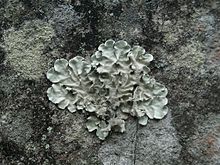| Parmotrema tinctorum | |
|---|---|

| |
| Scientific classification | |
| Domain: | Eukaryota |
| Kingdom: | Fungi |
| Division: | Ascomycota |
| Class: | Lecanoromycetes |
| Order: | Lecanorales |
| Family: | Parmeliaceae |
| Genus: | Parmotrema |
| Species: | P. tinctorum
|
| Binomial name | |
| Parmotrema tinctorum Hale 1974
| |
Parmotrema tinctorum is a lichen which belongs to the Parmotrema genus. The lichen is as known as the Palm Ruffle Lichen and is listed as secure by the Nature Conservatory.[1]
Description[edit]
Grows to around 3–30 cm in diameter with board dull smooth slightly shiny gray lobes that are 10–20 mm wide. The underside is black with naked brown areas with a central collection of simple rhizines.[2][3]
Habitat and range[edit]
Global distribution with a majority of samples being located in North America and Europe.[4]
Chemistry[edit]
Compounds derived from Parmotrema tinctorum have been found to have anti-cancer properties.[5]
Environmental monitoring[edit]
Parmotrema tinctorum has been identified and used as a candidate for monitoring air pollution.[6][7][8]
See also[edit]
References[edit]
- ^ a b "NatureServe Explorer – Parmotrema tinctorum". NatureServe Explorer Parmotrema tinctorum. NatureServe. 24 August 2022. Retrieved 24 August 2022.
- ^ "CNALH – Parmotrema tinctorum". lichenportal.org. Retrieved 24 August 2022.
- ^ Bungartz, Frank; Spielmann, Adriano A. (1 December 2019). "The genus Parmotrema (Parmeliaceae, lecanoromycetes) in the Galapagos Islands". Plant and Fungal Systematics. 64 (2): 173–231. doi:10.2478/pfs-2019-0018. ISSN 2657-5000. S2CID 210075798.
- ^ "Parmotrema tinctorum (Despr. ex Nyl.) Hale". www.gbif.org. Retrieved 24 August 2022.
- ^ Bhaktavalsala Suresh, Ashrini; Kilingar Nadumane, Varalakshmi (2021). "The metabolite 5-methyl-1,3-benzenediol and its derivative methyl-2,4-dihydroxy-6-methylbenzoate from the lichen Parmotrema tinctorum with potent apoptotic and anti-angiogenesis effects". 3 Biotech. 11 (7): 346. doi:10.1007/s13205-021-02883-9. ISSN 2190-572X. PMC 8212346. PMID 34178568.
- ^ Viana, Camila de O.; Vaz, Raissa P.; Cano, Abraham; Santos, Adelina P.; Cançado, Luiz G.; Ladeira, Luiz O.; Junior, Ary Corrêa (2015). "Physiological changes of the lichen Parmotrema tinctorum as result of carbon nanotubes exposition". Ecotoxicology and Environmental Safety. 120: 110–116. doi:10.1016/j.ecoenv.2015.05.034. PMID 26057077.
- ^ Palharini, Kelly Maria Zanuzzi; Vitorino, Luciana Cristina; Bessa, Layara Alexandre; de Carvalho Vasconcelos Filho, Sebastião; Silva, Fabiano Guimarães (2021). "Parmotrema tinctorum as an indicator of edge effect and air quality in forested areas bordered by intensive agriculture". Environmental Science and Pollution Research. 28 (48): 68997–69011. doi:10.1007/s11356-021-15411-2. ISSN 0944-1344. PMID 34286433. S2CID 236146509.
- ^ Boonpeng, Chaiwat; Polyiam, Wetchasart; Sriviboon, Chutima; Sangiamdee, Duangkamon; Watthana, Santi; Nimis, Pier Luigi; Boonpragob, Kansri (2017). "Airborne trace elements near a petrochemical industrial complex in Thailand assessed by the lichen Parmotrema tinctorum (Despr. ex Nyl.) Hale". Environmental Science and Pollution Research. 24 (13): 12393–12404. doi:10.1007/s11356-017-8893-9. hdl:11368/2902076. ISSN 0944-1344. PMID 28357804. S2CID 46159402.
